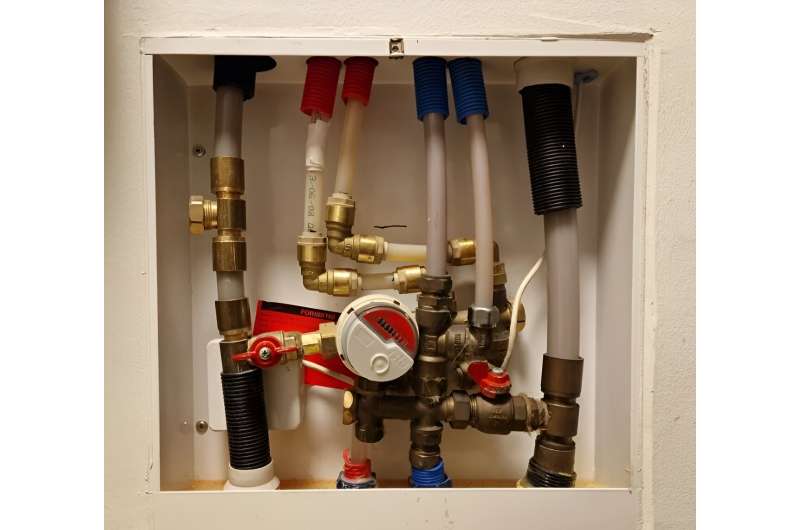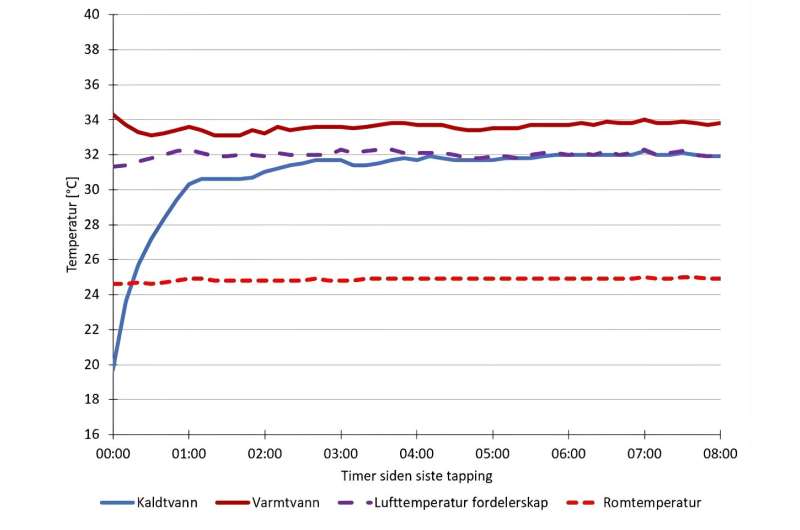This article has been reviewed according to Science X's editorial process and policies. Editors have highlighted the following attributes while ensuring the content's credibility:
fact-checked
trusted source
proofread
The wrong type of plumbing can increase the risk of Legionnaires' disease, researchers say

Pipe-in-pipe plumbing systems on the Norwegian market are tested and approved via the SINTEF Technical Approval System. However, plumbing installed in connection with so-called combi-cabinets has not been approved. The reason for this is the risk of establishing the Legionella bacterium that can cause serious lung infection, and which claims the lives of an unknown number of people each year.
The Legionella bacterium can establish itself in the biofilm that forms on the inside of water pipes, where it can reproduce if conditions are favorable. Once the bacterium has established itself in the plumbing system, it can be difficult to get rid of.
"A commonly used method is to flush the plumbing system with hot water. Unfortunately, recent research indicates that this has little effect," says Dag Fredrik Nedberg, who is an adviser at SINTEF Community.
Testing different distribution cabinets
In a pipe-in-pipe system, it is usually the case that heat transfer takes place between hot and cold water in the distribution cabinet. In order to investigate how different cabinet systems affect the temperature in standing cold water, we have compared the results of field measurements carried out in different types of distribution cabinets.
The poorest performers are the combi-cabinet systems, in which tap water and water for floor heating are installed side by side in the same cabinet. Not surprisingly, the floor heating system gives off a lot of heat. This causes the temperature in the cabinet to rise to as much as 40°C, offering the best possible temperature range for establishment of the Legionella bacterium.
Tap water is heated rapidly to the same temperature, and if the water remains standing in the system for some days, this will provide excellent growth conditions for the bacterium. Other types of distribution cabinet may also provide favorable conditions for bacterial growth, such as those connected to riser pipes, which are commonly installed in tall buildings.
In tall buildings, water seldom remains standing in the riser pipes, and there is a constant supply of new hot water that heats up the distribution cabinet. Our measurements showed that this type of cabinet exhibited temperatures of more than 30°C throughout a 24-hour period, providing ideal conditions for the establishment and growth of the Legionella bacterium.

Keep the water as cold as possible
The prevention of bacterial growth is thus all about maintaining the correct temperature conditions in the water pipes. Cold water must be kept at low temperatures, preferably below 20°C. In practice, this causes complications, because standing water in the plumbing system will soon acquire the same temperature as its surroundings.
According to SINTEF, cold water should be kept as cold as possible and never be allowed to become warmer than room temperature, regardless of how long it remains standing in the plumbing system. In order to achieve this, we must ensure that the cold water is not heated by other installations in the building. The best approach is to make sure that systems required to supply hot water are isolated as much as possible from cold water installations.
"Standard" water distribution cabinets, which supply only hot and cold tap water, performed surprisingly well during the SINTEF investigation. Even if the hot water system releases some heat, the temperature in the cabinets remained only a few degrees above room temperature.
"If we are to completely avoid heat transfer in our tap water systems, the best approach is to install the hot and cold water systems in separate cabinets. However, we believe that standard distribution cabinets accommodating both hot and cold tap water represent an acceptable solution," says Nedberg.




















